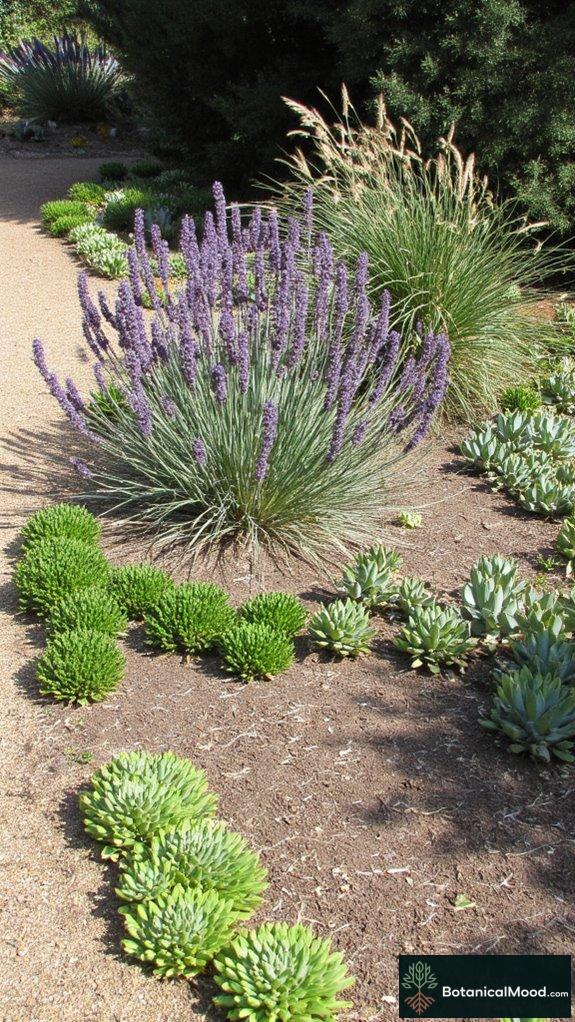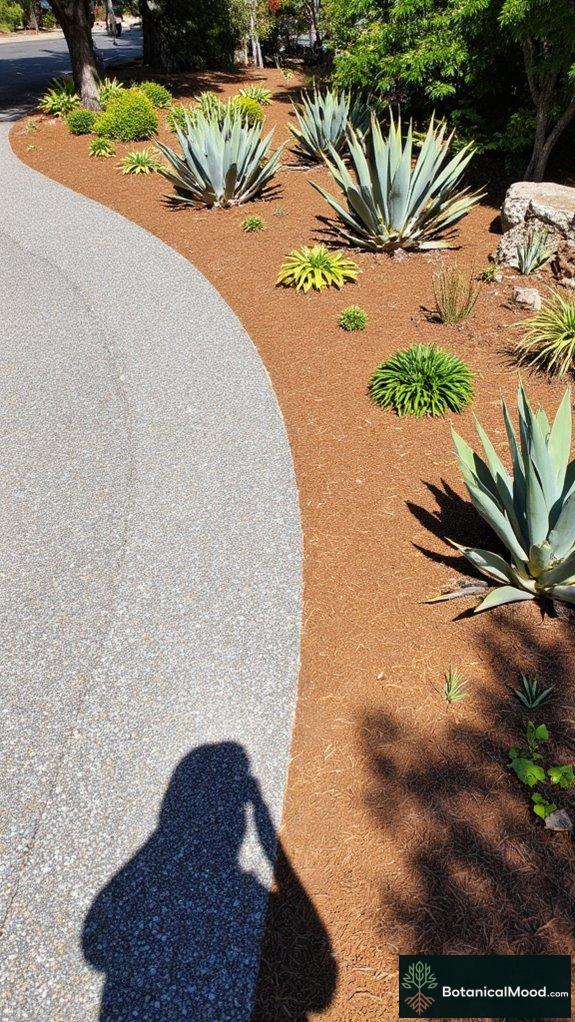Why does gardening have to be so complicated?
Let me tell you about my journey to creating drought-defying gardens.
I threw out the idea of traditional lawns and embraced xeriscaping instead. Who knew that using cacti like Echinocactus grusonii and Agave americana could make me feel like the ultimate gardening hero?
With drip irrigation—bless those little hoses!—and organic mulch that holds moisture like a champion, I crafted a vibrant oasis. It’s like a party for pollinators, and I’m the host!
But hey, who am I kidding? Droughts are tricky. Yet, with some creativity, you can thrive!
Designing Gardens That Actually Grow: My Personal Encounter with Drought-Resilient Landscapes
A few summers ago, I faced a garden crisis. My plants were drooping, begging for water. I decided to take a leap of faith and attended a workshop on garden design that focused on sustainable techniques. There, I learned about layering plants, incorporating rain gardens, and using native species.
Transforming my backyard into a drought-defying paradise was tough, but every plant contributed to the greater good—promoting biodiversity. Each time I saw bees buzzing around, I felt like I was revolutionizing the horticultural world.
Now, I marvel at how my garden flourishes, even when the sun blares down. Who knew smart sustainability could be this life-changing?
Quick Takeaways
- Xeriscaping utilizes native, drought-resistant plants to create sustainable gardens that thrive in various climates and support local biodiversity.
- Efficient irrigation techniques, such as drip systems and rainwater harvesting, optimize water use and maintain healthy plant growth.
- Mulching with organic materials retains moisture and suppresses weeds, improving the overall health of drought-tolerant gardens.
- Grouping plants by water requirements enhances irrigation efficiency and ensures that each plant receives the necessary moisture.
- Resourceful tools and local nurseries provide essential support for developing resilient gardens that flourish with minimal water.
Understanding Xeriscaping and Its Benefits

When I first explored the world of gardening, I was captivated by the concept of xeriscaping, which involves designing terrains that thrive in arid conditions, maximizing water efficiency and minimizing maintenance.
The xeriscaping principles emphasize strategic planning, incorporating native plants, efficient irrigation methods, and soil enhancement to create sustainable, drought-tolerant landscaping.
I learned to appreciate how using materials like gravel or mulch conserves moisture while allowing vibrant colors and textures to flourish, showcasing nature’s artistry. Additionally, incorporating native desert plants supports local wildlife and promotes biodiversity, creating a balanced ecosystem.
Choosing the Right Drought-Resistant Plants

How do you select drought-resistant plants that not only endure harsh conditions but also add beauty and interest to your scenery?
I start by exploring native species, as they naturally thrive in our local climate and exhibit incredible climate adaptability. For instance, Agastache foeniculum, commonly known as anise hyssop, not only attracts pollinators but also withstands dry spells.
I also recommend incorporating succulents like Echeveria or Sedum, which offer vibrant colors and unique textures. Creating a drought-resistant native plant garden layout enhances the aesthetic while conserving water.
Combining these plants with ornamental grasses, such as Panicum virgatum (switchgrass), can create striking contrasts.
Focusing on these elements enhances the aesthetic while conserving water. This thoughtful selection guarantees your garden not only survives but flourishes, embodying the spirit of Smart Sustainability.
It’s a demonstration of resilience and beauty.
Efficient Irrigation Techniques for Water Conservation

As I explore the art of cultivating a thriving garden under water-scarce conditions, efficient irrigation techniques become essential for conserving every precious drop.
Employing drip systems, for instance, delivers water directly to the plant roots, minimizing evaporation and runoff while maximizing efficiency. These systems not only reduce water usage considerably but also help maintain healthy soil moisture levels, essential for robust growth.
Drip systems provide efficient irrigation by targeting plant roots directly, conserving water and enhancing soil moisture for optimal growth.
Rainwater harvesting is another powerful tool at our disposal. By capturing and storing rainwater, I can provide my garden with a sustainable irrigation source that thrives even in dry spells.
Utilizing these methods not only champions sustainability but profoundly blends beauty and practicality, creating an environment that flourishes and inspires, all while respecting nature’s limitations.
The Role of Mulching in Xeriscape Design

The integrity of a garden thrives on multiple layers of thoughtful design, and mulching plays an essential part in nurturing xeriscape environments.
Selecting the right mulch types—like organic materials such as shredded bark, wood chips, or even gravel—ensures effective moisture retention. These layers not only reduce evaporation but also suppress weeds that might compete for limited resources.
I’ve seen how a thick layer of mulch in my own garden dramatically enhances the soil’s ability to retain precious water, allowing hardy plants like Agave americana and Sedum spp. to flourish even in the scorching sun.
Soil Preparation for Maximum Moisture Retention

Preparing the soil for maximum moisture retention is essential if we want our xeriscape gardens to truly thrive in arid conditions. Start by testing your soil’s pH and structure; this foundational step empowers you to choose the right soil amendments.
Incorporate organic matter like aged compost (Humus) or well-rotted manure, which considerably enhance moisture retention, creating a sponge-like environment.
I often mix in water-retentive gels or natural fibers, such as coconut coir (Cocos nucifera), that deeply embed moisture within the soil matrix.
Creating Visual Interest in Drought-Defying Gardens

Gardens can be strikingly beautiful, even in the face of drought. By incorporating colorful contrasts, such as the fiery reds of Sedum spurium paired with the cool greens of Lavandula angustifolia, we create an eye-catching display that defies arid conditions.
Textured layers add depth, enticing viewers to explore. For instance, the spiky forms of Agave americana juxtaposed with the soft, cascading petals of Santolina chamaecyparissus can evoke a sense of dynamic movement.
In my pursuit of crafting powerful vistas, I find inspiration in native flora that thrives under harsh conditions, showcasing resilience.
As I curate each drought-defying garden, I’m reminded that aesthetics and sustainability can coexist, making the vista an enduring expression of beauty, even amid challenges.
Planning Your Xeriscape Layout and Plant Grouping

When I consider the layout of a xeriscape, I often envision a harmonious blend of functionality and aesthetic appeal, ensuring that each element complements the overall design. Planning your xeriscape effectively involves strategic garden zoning and careful plant placement. By grouping plants with similar water needs, I create a sustainable haven that thrives with minimal resources.
Here’s a table to visualize effective plant groupings:
| Plant Type | Water Needs | Ideal Placement |
|---|---|---|
| Succulents (Echeveria) | Low | Sun-drenched borders |
| Native Grasses (Muhlenbergia) | Moderate | Middle zones |
| Perennials (Lavandula) | Low | Front arrangements |
| Groundcovers (Thymus) | Very Low | Understory areas |
| Shrubs (Rudbeckia) | Moderate to Low | Focal points |
This structured approach not only beautifies but fortifies resilience in my garden designs.
Maintenance Strategies for Sustainable Landscaping

While many might assume that xeriscaping requires little attention, I believe that effective maintenance strategies are essential for ensuring the longevity and sustainability of these drought-defying gardens.
Implementing proper drainage solutions is critical; heavy rains can saturate your scenery, so let’s incorporate a dry creek bed or rain garden to direct excess water away from sensitive plants.
Regular garden maintenance, including seasonal pruning of native shrubs such as Salvia (Salvia spp.) and ornamental grasses like Miscanthus (Miscanthus sinensis), preserves not just shape but health, enabling each specimen to thrive.
I encourage the use of organic mulch to retain moisture and suppress weeds, enhancing the aesthetic appeal.
Embracing these practices elevates your garden into a resilient masterpiece, thriving amid challenges while echoing nature’s ingenuity.
Sustainable Garden Planning

Creating a sustainable garden requires a thoughtful approach that encompasses both beauty and function, allowing us to nurture our plants while respecting the environment.
To begin, I strategically plan my vegetable garden, integrating native species like Echinacea purpurea and Asclepias tuberosa, which not only thrive in local conditions but also attract pollinators.
I prioritize companion planting, pairing tomatoes (Solanum lycopersicum) with basil (Ocimum basilicum) to enhance flavor and deter pests.
I’m also mindful of sun exposure and soil quality, choosing the perfect location to maximize growth.
Utilizing organic mulch helps retain moisture while enriching the soil.
Water-Wise Desert Garden Design

Designing a water-wise desert garden not only fosters a sustainable scenery but also enhances the visual harmony of arid environments. By carefully selecting desert plants (such as Agave americana or Echinocactus grusonii) that require minimal water, I guarantee a terrain that thrives even in extreme conditions.
Here are some key elements to reflect upon:
- Grouping plants by similar water requirements optimizes efficiency and encourages climate adaptation.
- Testing and amending soil elevates nutrient absorption and overall plant resilience. Additionally, implementing drip irrigation systems ensures efficient water delivery while conserving resources.
- Utilizing vertical gardening expands planting opportunities, allowing diverse textures and colors to bloom.
This vibrant approach redefines desert gardening, making it more than just survival; it’s a striking portrayal of nature’s beauty in harmony with limited resources.
Irrigation-Efficient Garden Layout

Achieving irrigation efficiency in garden layouts fundamentally enhances both plant health and resource conservation, especially in environments where water is a precious commodity. By strategically organizing plant placement, I group species with similar water needs into tailored irrigation zones, ensuring optimal water usage and reducing waste.
Irrigation efficiency is key to nurturing plant health and conserving precious water resources in sustainable gardening.
For instance, I segregate drought-tolerant plants (like Salvia spp.) from shade-loving varieties (such as Hosta spp.), creating distinct zones that prevent over- or under-watering.
The right irrigation layout, whether employing end-fed tubing or center-fed designs, adapts to each garden’s unique contours, enhancing efficiency. Careful attention to soil types and topography further refines my approach.
Ultimately, these thoughtful choices nurture a thriving ecosystem while conserving invaluable water resources, all essential in my quest for sustainable gardening excellence.
Meet the Garden Visionary

From San Diego, California, the visionary garden designer, Johnson, cultivated her passion for sustainable gardens after witnessing the adverse effects of drought in her community, motivating her to create lasting ecological spaces.
Through a meticulous design process, Johnson incorporated xeriscaping principles, selecting native plants and efficient irrigation systems. Collaborating with local horticulturists, she guaranteed her garden not only beautified the area but also contributed to the biodiversity and resilience of the local ecosystem.
To bring her vision to life, Johnson utilized tools like drip irrigation systems from Rain Bird and organic compost from Miracle-Gro.
Furthermore, she sourced drought-tolerant plants from local nurseries and employed decorative accessories such as natural mulch from Gardener’s Supply Company to enhance her garden’s functionality and aesthetic appeal.
Iconic Botanical Gardens Nationwide
The beauty and diversity of botanical gardens across the United States offer a vibrant demonstration to nature’s resilience and artistry.
Consider these iconic gardens, each an illustration of the splendor of plant life:
- Longwood Gardens, Pennsylvania: Spanning over 1,100 acres, it boasts 10,000 species and the largest green wall in America.
- United States Botanic Garden, D.C.: Known for its museum exhibits and multisensory experiences, it ignites passion for conservation.
- New York Botanical Garden, New York: As a hub for art and science, it showcases themed displays that celebrate natural beauty.
These urban gardens inspire challenges to traditional gardening norms, encouraging innovative, drought-resistant designs that unite aesthetic with practicality—essential in today’s changing climate.
References
- https://otolawn.com/blogs/lawn-care-101/the-benefits-of-xeriscaping-for-water-conservation-and-drought-tolerance
- https://www.shrubhub.com/blog/learn-how-xeriscape-landscape-design-is-the-best-solution-to-your-drought-concerns.php
- https://extension.psu.edu/designing-the-home-garden-for-drought-resilience/
- https://extension.illinois.edu/rainfall-management/xeriscaping
- https://pubs.nmsu.edu/_h/H707/index.html
- https://www.justsprinklers.com/blog/2025/september/modern-drought-resistant-landscaping-ideas/
- https://engagement.source.colostate.edu/xeriscaping-beginners-guide-drought-tolerant-landscaping/
- https://www.nidwater.com/what-is-xeriscaping
- https://agriscaping.com/desert-garden-design-tips/
- https://blog.moonvalleynurseries.com/texas/xeriscape-101-your-guide-to-water-wise-landscaping-in-2022
- https://www.moananursery.com/2022/06/06/designing-your-high-desert-garden/
- https://www.dianasdesignsaustin.com/2016/02/use-water-wise-tips-create-low-maintenance-beautiful-xeric-garden/
- https://growinginthegarden.com/sunken-garden-beds-water-wise-gardening-in-the-desert/
- https://kellogggarden.com/blog/gardening/4-steps-water-wise-garden/
- https://water.ca.gov/water-basics/conservation-tips/plant-and-landscape-guide
- https://www.gardendesign.com/water-wise/
- https://www.powerproplumbing.com/blog/guide-to-efficient-irrigation-systems
- https://www.youtube.com/watch?v=7Jx_fYG4jBM
- https://extension.usu.edu/yardandgarden/research/designing-a-basic-pvc-home-garden-drip-irrigation-system
- https://www.gardenstylesanantonio.com/garden-articles/designing-for-irrigation-efficiency/
- https://www.finegardening.com/project-guides/gardening-basics/setting-up-a-garden-drip-irrigation-system
- https://www.gardenary.com/blog/how-to-set-up-a-super-simple-irrigation-system-for-raised-garden-beds
- https://www.rainbird.com/homeowners/blog/irrigation-for-theme-gardens
- https://www.rainbird.com/homeowners/blog/planning-a-drip-irrigation-system
- https://www.gardenia.net/gardens/tolerance/drought-tolerant
- https://www.dynascape.com/blog/drought-tolerant-landscaping/
- https://anglerlawn.com/2024/02/21/drought-resistant-landscaping-south-florida/
- https://www.createacademy.com/studio-notes/guide-to-drought-tolerant-gardens
- https://wildones.org/webinar-landscaping-for-resilience/
- https://www.houzz.com/professionals/landscape-architect/project-type-drought-tolerant-landscaping-probr1-bo~t_11788~sv_29260
- https://www.youtube.com/watch?v=o9eU12jcdmY
- https://www.design-scapes-inc.com/how-to-design-a-drought-tolerant-garden/
- https://heritagelandscapes.net/blog/top-10-drought-tolerant-plants-for-your-garden
- https://www.islands.com/1900855/largest-longwood-botanical-garden-america-between-gettysburg-philidelphia-pennsylvania/
- https://en.wikipedia.org/wiki/List_of_botanical_gardens_and_arboretums_in_the_United_States
- https://www.pacaso.com/blog/top-10-botanical-gardens-in-the-u-s
- https://www.publicgardens.org/20-most-popular-us-botanical-gardens/
- https://www.usbg.gov
- https://www.nybg.org
- https://longwoodgardens.org

Leave a Reply